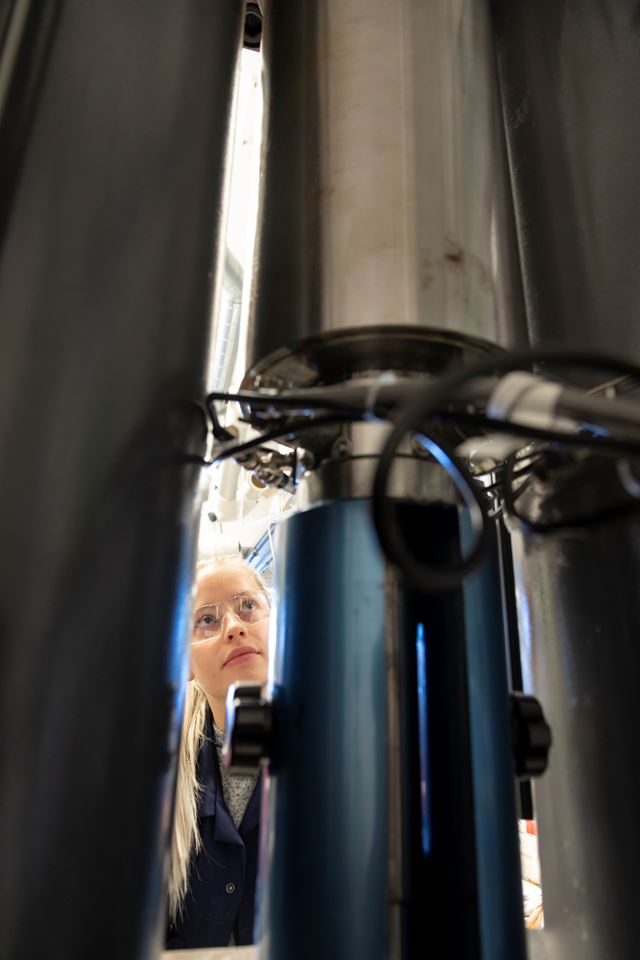In mature fields on the Norwegian shelf – those that have been producing for some time – fluid pressure in the reservoir is reduced, resulting in lower resistance to the forces to which the reservoir rock is exposed. These forces cause sand and rock fragments to break loose from the well walls and mix with the oil or gas streams. This is called “sand production” and is a problem that applies particularly to older fields.
“To exploit the resources in developed fields, it pays to produce as efficiently as possible from existing wells, and this requires knowledge of how to produce when the risk of sand production increases. This is what we are now able to predict more accurately,” says Andreas Berntsen at SINTEF.
Taming enormous forces
Oil and gas are found primarily in layers of porous sandstone, where they fill pores in the same way as a liquid fills a sponge. Some of the most common reservoirs consist of sand grains that have become cemented together over geological time to form sandstones buried several kilometres below the surface.
If too much sand is produced from a well, it will cause disproportionately high wear and tear on valves and pipes. It can also result in plugging of the well, blocked equipment and reduced productivity. The sand must also be separated from the production stream, cleaned and disposed of.

Euripides Papamichos at SINTEF is in charge of the project. Photo: Thor Nielsen
Wells have to be drilled down into the reservoir to enable production of the oil or gas. When the valves are opened, oil and gas will stream out from the porous rocks into the well and up to the production platform or into pipelines on the seabed.
“Reservoirs often lie at a depths of between two to five kilometres and the weight of overlying rock formations will subject the reservoir rock to considerable strain. The area
immediately adjacent to the well is most vulnerable to damage if the rock is at the limit of what it can withstand,” says Euripides Papamichos, the senior research scientist in charge of the project at SINTEF.
Old field of research
Sand production has therefore been an important subject of research for 25 years, both in order to understand the mechanisms at play and also to enable the prediction, handling, limitation or prevention of the phenomenon.
An important element of the research effort is the laboratory testing of sandstone, obtained either from quarries or directly from an oil field. A cylindrical hole is drilled into the sandstone sample, like a small-scale well. The rock is then placed in a pressure chamber where it is subjected to stresses imitating those in a reservoir. Large hydraulic rams apply varying pressure in different directions while oil permeates through the rock and into the well. As the stresses increase, it is possible to observe sand in the oil stream as the rock around the well becomes crushed.
Facts about the project:
The principal objectives of this research project are to:
- avoid sand production or keep it under control, and to find the limits of profitable production in older oil and gas fields. In petroleum terminology this is known as “sand management”.
- increase the recovery factor of existing oil fields and reduce the need for new field discoveries.
- reduce the environmental impact by prolonging a field’s lifetime and avoiding sand processing.
- develop computer tools that operators can use to predict sand production under various conditions.
The project is a knowledge-building project for industry (KPI), financed via the Research Council of Norway’s PETROMAKS 2 programme and by industrial partners. Both industry and academia are represented: Texas A&M in the US, Waseda University in Tokyo and NTNU are research partners, while industry is represented by Aker BP, Wintershall Dea Norge and American companies Hess, Occidental and ExxonMobil.
“In the lab we can control pressure and flow and reproduce the stress and flow conditions that exist in various fields. We can also measure sand production and observe how the well walls are eroded. Based on this we can create models of when sand production will begin and how it will develop over time for different rocks. This is much more difficult to measure in the field, so the laboratory tests are valuable,” says Berntsen.

Laura Edvardsen (M.Sc.) places a sandstone sample in the machine, where its strength will be tested using forces exerted from all directions. Photo: Thor Nielsen
Forces impact the reservoir from all directions
The vertical stress is the greatest, while the horizontal stresses are often somewhat smaller. Assuming that the stresses in the horizontal plane are equal in all directions makes the calculations and laboratory tests simpler. Most laboratories are not able to vary them independently anyway. The problem is that this does not represent the real picture in the majority of field situations.
“In addition, long, inclined or horizontal wells have become more common and this makes the stress pattern much more complex. We know that rock strength depends on the stress pattern, and this affects sand production. However, only True Triax allows us actually to test the effect of the stress pattern,” Lars Erik Walle of SINTEF Industry explains. He is referring to the department’s latest major investment, the True Triaxial Test System, which can vary stresses in all three directions.
Specially developed monster machine
The True Triax machine is the only one of its type that can imitate conditions prevailing up to ten kilometres beneath the surface while allowing liquid flow at high temperature. The equipment is specially constructed for this laboratory, weighs ten tonnes and, has an output of 800 tonnes force on rock samples measuring up to half a metre in diameter.
· Read more and watch the video of tests using the “super machine” in the Gemini article “Revealing geology’s X-factor”.
For many years, SINTEF scientists have been developing test methods for studying sand production in the laboratory, but only now does the equipment permit the simulation of truly realistic stress conditions. Work on this project has been going on since 2017, and SINTEF scientists have now enlisted a Ph.D. research fellow at NTNU who will make a specific study of how sand production takes place in gas fields.
From physical measurements to computer models
The physical measurements from the laboratory tests, combined with models and simulations, are being used to develop a software application for estimating sand production.
“We are building up a large knowledge base using different sandstones in the tests. However, all rocks are different, so our industry partners send reservoir rock samples direct from the field to be tested by us so that we can calibrate our models. Information from wells is then incorporated into the software, which calculates sand production from various parts of the well under given conditions. In this way the operators can compare different production methods,” says Papamichos.


